How can one introduce Emeka Eze? He’s Nigerian. He’s just 22 years old and he’s already lived in four nations, playing football at the highest level in three of them. He’s clearly well-travelled and mature beyond his years. At the same time, there is a naivety about him. In the two years that he’s played for Austrian club Sturm Graz, he’s managed just 30 appearances. Furthermore, he’s only scored twice. Despite all this, however, there is a real dynamism to his play but it just doesn’t seem to have been welcomed in Austria.
In this tactical analysis, by observing his last five matches, we shall see how Eze has been unjustly withheld from the Sturm Graz attack. The forward is trying his best to imprint his image upon both his club side, as well as the wider Austrian Bundesliga. His aggressive, physical, dynamic playing style is complemented by his own intelligence and technical ability. Sadly, he has often not had the chance, managing a paltry 26.2 minutes of play in his last five games. If new Sturm coach Nestor El Maestro unleashes Eze, we could well see a storm emerging in south-eastern Austria.
Thunderstruck
Eza’s physical appearance is one which would surely lead to famous fan chants if he were to ever play in the United Kingdom. If I were a German, Finnish, or French speaker, perhaps I would know how he has been referred to in his domestic career. With his Mohawk, ear studs, gap-tooth-trimmed eyebrows and silvery snarl, he’s made a big effort to become the punk rocker of central European football. All the same, these only add to the gifts bestowed on him naturally.
Despite measuring just over six feet tall, the sheer broadness across his chest has given him a boxy appearance which has turned him into a battering ram for Sturm Graz. Naturally, these features have all been incorporated into his playing style and he’s become an almost aerial master for Sturm. The forward has won an average of 6.28 aerial duels per game this season, according to WyScout. He constantly looks to drop deep and flick the ball on to an overlapping left-winger. This is seen in the below images:
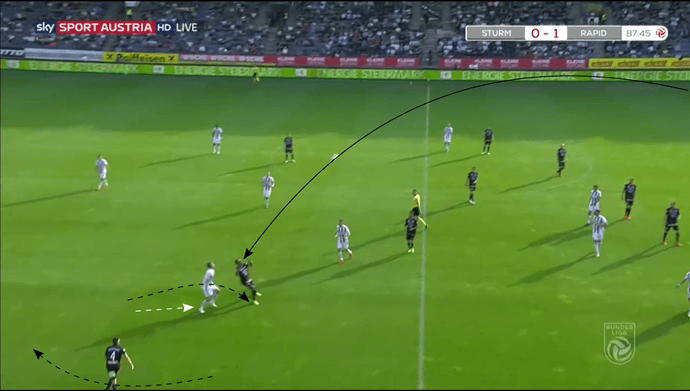
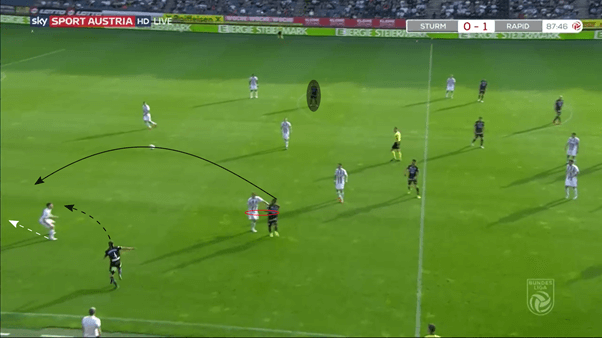
This significance of Eze’s strength is that he has become a foil for his side. In his last five games, Eze has notably not scored. In fact, he only recorded three shots on goal. His xG was therefore pretty dismal, at an average of 0.14. At the same time, this isn’t his game and this is perhaps not assisted by how Sturm have recently been playing under Roman Mählich.
Within each of Eze’s last five games, he’s almost always been brought on to be a focal point of the attack. Usually, when faced with a high press which defines Germanic football, this has often led to the defence and midfield being squeezed to the edge of Sturm’s penalty area. Huge gaps usually cut him off from the rest of his side in their basic attacking starting positions.
Long balls and clearances look to target Eze, and he does well to win the ball. This doesn’t mean that this is what gets the best out of him, however. Likewise, when isolated up front, forcing him into the corners appears to be the best position to get Eze to turn over the ball. Eze does well within these compromised positions but when faced with little support, there is only so much that he can do.
Blinded by the light
This is where it gets really interesting when trying to dissect Eza’s recent performances. Yes, he is strong and powerful, and this will do a good job in allowing him to have a leg-up over defenders. At the same time, however, he is not simply reliant on strength and body weight to overpower defenders.
Crucially for Eze, his intelligence allows him to strike at the heart of his opponents’ defence. He has an excellent understanding of positioning, especially when it comes to getting into the correct areas. In these areas, a tactical analysis of his performances shows us what patterns and trends come about. Much of this is influenced by how he is often played by Sturm.
In his last five games for the side, he’s almost always been played through the middle, most often up front on his own. The one performance through which he played on the left of the attack, coming off the bench to try and unsuccessfully inspire a victory over Austria Wien, he was only on the field for 14 minutes.
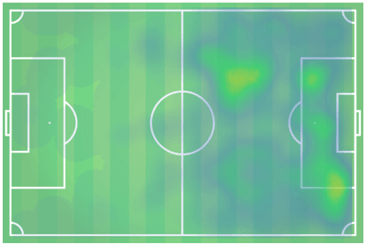
At the same time though, as the heat map above demonstrates, there is a difference within his positioning as the side moves through the different stages of their play. Under Mählich, the first phase of play was usually a long ball from the goalkeepers or the defenders from the centre. In fact, 14.96% of their passes were long. In their last six games, only one side had a higher long pass percentage on a game-by-game basis. As we can see, Eze finds himself deeper on the left. He hopes to drop to win the ball or ideally flick the ball behind him for an onrushing left midfielder.
As we can see though, there are also distinct and blinding hot points on the right. Interestingly, I would hypothesise that these movements to the back posts still correspond with attacks down the left, but with Sturm not in the latter stages of play. Eze knows that his attacking prominence in the air is a legitimate weapon. Being able to cut across a defender and attack the ball is seen time and again.
Yet, once again, with the side heavily prioritising getting the ball forwards quickly (in three of their last six games, they’ve taken less than three passes per possession), Eze is unable to really operate in this area. Sturm need to base their attacking play around the forward.
It never rains but it pours
I’m no meteorologist, but a quick Google search of Graz’s recent rainfall shows a fearsome trend. Since Eze moved to the city in 2017, Graz’s wettest patches of the year have seen significant historical peaks. This last May, when Eze played twice, Graz recorded 183.2mm of rain. This is the highest amount which I could find going back to 2009.
Whilst it would be wrong to build him up to almost mythical proportions, we can’t deny that he is both a character and presence on the pitch. Like the rain, furthermore, he’s widely despised by those who must don their macs and face it. Physically he is a menace but it is his sheer persistence and aggression which makes him so difficult to face.
This is not to say that this is always a positive thing. Watching Eze in his last five appearances has frankly, been sometimes rather frustrating. He’s made, on average, 2.95 fouls per game this season. Considering that Sturm have made, on average, 12.78 per game, he’s made nearly a quarter of the sides’ fouls. Part of this comes out of the Nigerian’s own sense of frustration.
The question then really becomes how a side can get the best out of Eze’s aggression in terms of attack. In practice, this could be by Sturm better implementing a counter-pressing style. In the below graphics, we can see Sturm Graz retreating and the positions which Eze tends to find himself at the forefront of. Yet, a lack of co-ordination in the press seems common within the Sturm team. As the side drop, he is left isolated without cover on either side and with a huge space between him and the midfield.
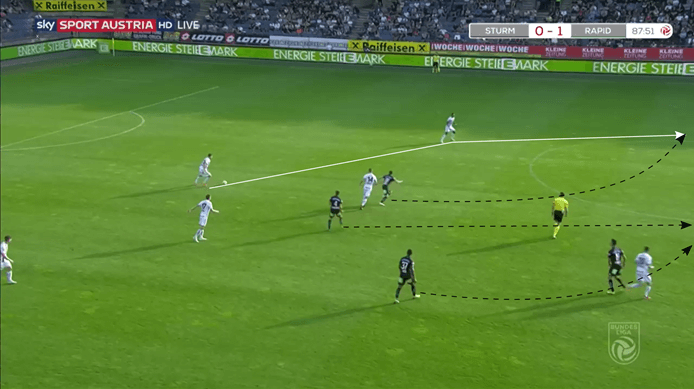
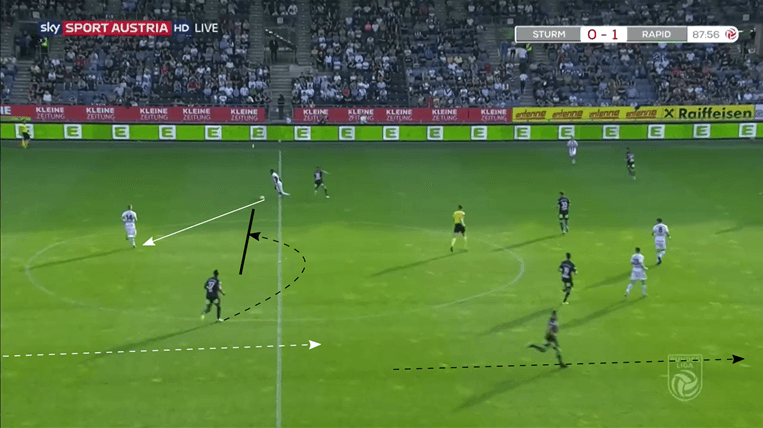
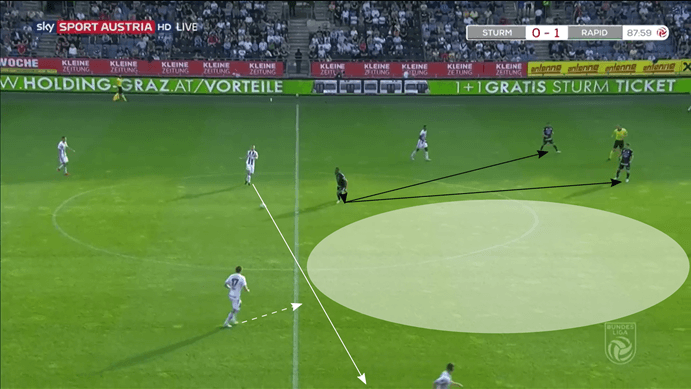
Interestingly, Graz don’t appear to press as high up the pitch when Eze is in the side, which seems disappointing considering that he averages 2.95 defensive duels per game, with 71.7% in the opposition half. Positioning him up front on his own, which Mählich has been keen to do, only sees the opposition grating down the Sturm defensive shield. Eze, at its edge, is often dragged across the pitch, with his defensive positioning being nullified.
This ultimately only leads to gaps emerging through which Sturm can be penetrated. El Maestro must better buttress the Sturm blockade next season. Eze’s tenacity would make him a highly effective defensive forward. His aggressiveness and desire to win the ball should be better utilised higher up the pitch. He is capable of transforming defence into attack in an instant. Once again, however, he has been let down in this regard. Even if it were a case of him ignoring his coach’s instructions and isolating himself, the extra depth of his teammates means that winning the ball deeper would still negate his ability further forward.
The wayward hurricane
Finally, and this is perhaps often overlooked for Eze as he is usually used to link play and is already well positioned when the ball is played, but he is rapid. It is a difficult point to justify, in that, as has already been alluded to, Sturm often don’t deploy Eze in a role which really allows him to get the most out of his explosive pace. He’s a decent target man, but his pace behind could be better utilised. Sturm could do one or the other but rather, they’ve chosen to do neither.
There is another side to this, and to be fair to fellow teams within the Bundesliga, Eze is treated with due respect. His physical prowess draws defenders onto him and as such, he is largely prevented from being able to demonstrate his pace. He’s subject to an average of 2.43 fouls per game from the opposition. He is feared yet his club have done nothing to protect him and supplement his talents.
Unfortunately then, there is an element of this which means that his pace is only utilised under certain circumstances. Often these are when retreating into a defensive position, or when sprinting into a transition from within his own half. In fact, considering the fact that he has recently been brought on as a crucial centre forward, his retraction into defensive areas is troubling. Again, this only contributes to the narrative that Eze feels the need to drop deeper to make a difference.
The answer to how best to use his acceleration sits in front of us in every passing game. He does enjoy making channel runs but this level of strenuous man-marking is often hard to shake, even with his level of pace. Often times, we can see that there are areas where using his pace could be better deployed, and this goes hand-in-hand with his positioning. If he can use this pace into moving into areas of the pitch with open space, we could see him delivering more in front of goal. In order to do this, however, Sturm must also adapt their game. They must look for his desired runs into the half spaces.
At the same time, Eze could do more to help his teammates. In the below graphics, we can see how when moving the ball down the flank, Eze merely runs parallel to the ball, this is not surprising and hugely frustrating. In this scenario, in all fairness, this was perhaps the best movement to make, as he could explode through the gap behind the defence. The move started from a brilliant first touch which turned the defender in a very deep position. The bombarding right-winger gives him an excellent outlet out wide. Unfortunately, the return pass was blocked.
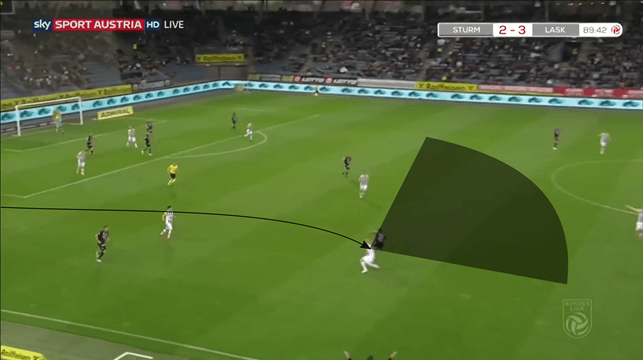
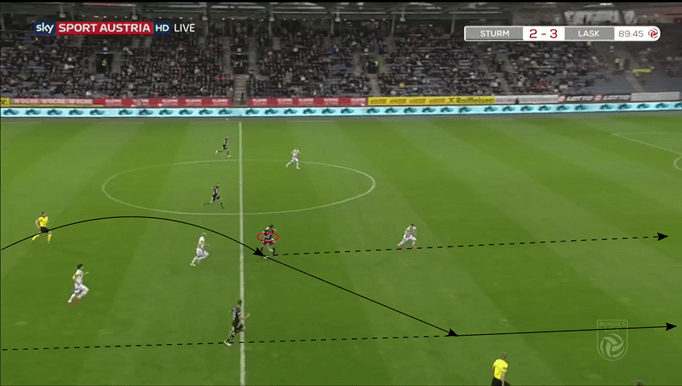
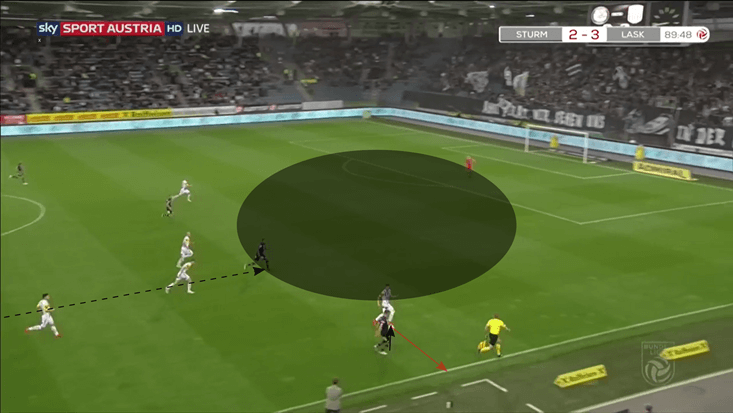
Conclusion
We can make several broad assumptions from this tactical analysis and based on the evidence before us. The first is that there should be real questions about Eze’s desire to stay with the side. Whilst Mählich has been deposed and replaced by El Maestro, Eze should surely be looking for greater assurances over his playing time. More so, Eze’s playing style has been highly underutilised in his time at the club, and he needs to play in a side on the front foot and with support.
Naturally, with being played sparingly and having a dismal return with regard to shots (let alone goals) and assists, where will Eze have the chance to go? Modern football statisticians may even miss the Nigerian’s potential due to him hardly gaining traction within the minds of his domestic coaches. All the same, the young striker is a versatile and hardy attacker. Born in Africa and trained on the battlegrounds of northern and central Europe, he’s got a repertoire as interesting as his passport. He’s the raw talent which forecasts can’t predict.
If you love tactical analysis, then you’ll love the digital magazines from totalfootballanalysis.com – a guaranteed 100+ pages of pure tactical analysis covering topics from the Premier League, Serie A, La Liga, Bundesliga and many, many more. Buy your copy of the May issue for just ₤4.99 here, or even better sign up for a ₤50 annual membership (12 monthly issues plus the annual review) right here.

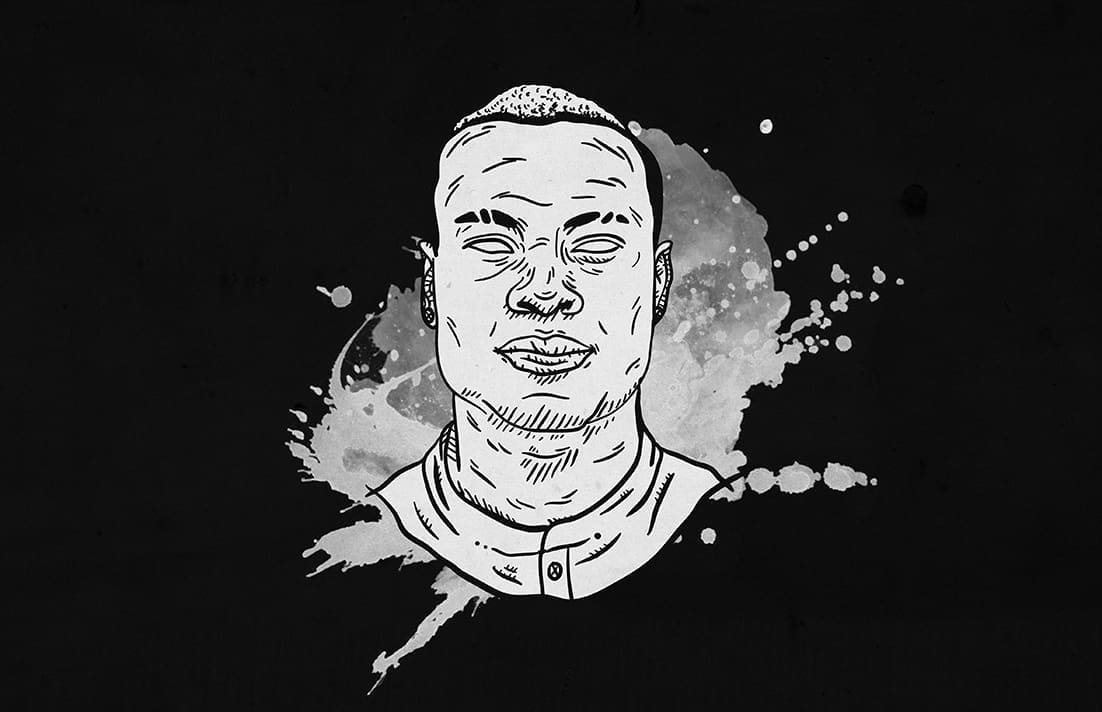



Comments